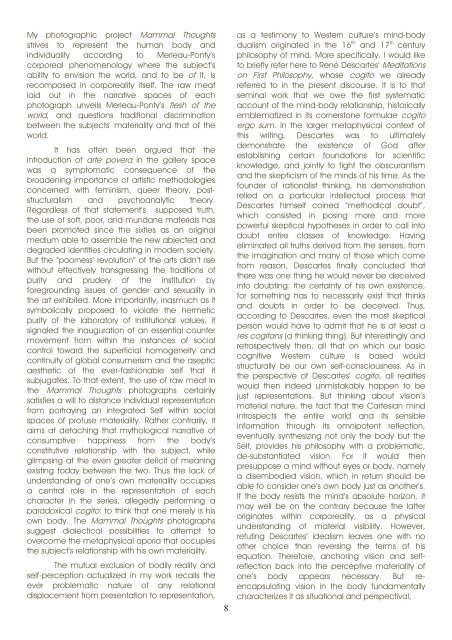Meet Animal Meat - Antennae The Journal of Nature in Visual Culture
Meet Animal Meat - Antennae The Journal of Nature in Visual Culture
Meet Animal Meat - Antennae The Journal of Nature in Visual Culture
Create successful ePaper yourself
Turn your PDF publications into a flip-book with our unique Google optimized e-Paper software.
My photographic project Mammal Thoughts<br />
strives to represent the human body and<br />
<strong>in</strong>dividuality accord<strong>in</strong>g to Merleau-Ponty’s<br />
corporeal phenomenology where the subject’s<br />
ability to envision the world, and to be <strong>of</strong> it, is<br />
recomposed <strong>in</strong> corporeality itself. <strong>The</strong> raw meat<br />
laid out <strong>in</strong> the narrative spaces <strong>of</strong> each<br />
photograph unveils Merleau-Ponty’s flesh <strong>of</strong> the<br />
world, and questions traditional discrim<strong>in</strong>ation<br />
between the subjects’ materiality and that <strong>of</strong> the<br />
world.<br />
It has <strong>of</strong>ten been argued that the<br />
<strong>in</strong>troduction <strong>of</strong> arte povera <strong>in</strong> the gallery space<br />
was a symptomatic consequence <strong>of</strong> the<br />
broaden<strong>in</strong>g importance <strong>of</strong> artistic methodologies<br />
concerned with fem<strong>in</strong>ism, queer theory, poststructuralism<br />
and psychoanalytic theory.<br />
Regardless <strong>of</strong> that statement’s supposed truth,<br />
the use <strong>of</strong> s<strong>of</strong>t, poor, and mundane materials has<br />
been promoted s<strong>in</strong>ce the sixties as an orig<strong>in</strong>al<br />
medium able to assemble the new abjected and<br />
degraded identities circulat<strong>in</strong>g <strong>in</strong> modern society.<br />
But the “poorness’ revolution” <strong>of</strong> the arts didn’t rise<br />
without effectively transgress<strong>in</strong>g the traditions <strong>of</strong><br />
purity and prudery <strong>of</strong> the <strong>in</strong>stitution by<br />
foreground<strong>in</strong>g issues <strong>of</strong> gender and sexuality <strong>in</strong><br />
the art exhibited. More importantly, <strong>in</strong>asmuch as it<br />
symbolically proposed to violate the hermetic<br />
purity <strong>of</strong> the laboratory <strong>of</strong> <strong>in</strong>stitutional values, it<br />
signaled the <strong>in</strong>auguration <strong>of</strong> an essential counter<br />
movement from with<strong>in</strong> the <strong>in</strong>stances <strong>of</strong> social<br />
control toward the superficial homogeneity and<br />
cont<strong>in</strong>uity <strong>of</strong> global consumerism and the aseptic<br />
aesthetic <strong>of</strong> the ever-fashionable self that it<br />
subjugates. To that extent, the use <strong>of</strong> raw meat <strong>in</strong><br />
the Mammal Thoughts photographs certa<strong>in</strong>ly<br />
satisfies a will to distance <strong>in</strong>dividual representation<br />
from portray<strong>in</strong>g an <strong>in</strong>tegrated Self with<strong>in</strong> social<br />
spaces <strong>of</strong> pr<strong>of</strong>use materiality. Rather contrarily, it<br />
aims at detach<strong>in</strong>g that mythological narrative <strong>of</strong><br />
consumptive happ<strong>in</strong>ess from the body’s<br />
constitutive relationship with the subject, while<br />
glimps<strong>in</strong>g at the even greater deficit <strong>of</strong> mean<strong>in</strong>g<br />
exist<strong>in</strong>g today between the two. Thus the lack <strong>of</strong><br />
understand<strong>in</strong>g <strong>of</strong> one’s own materiality occupies<br />
a central role <strong>in</strong> the representation <strong>of</strong> each<br />
character <strong>in</strong> the series, allegedly perform<strong>in</strong>g a<br />
paradoxical cogito: to th<strong>in</strong>k that one merely is his<br />
own body. <strong>The</strong> Mammal Thoughts photographs<br />
suggest dialectical possibilities to attempt to<br />
overcome the metaphysical aporia that occupies<br />
the subject’s relationship with his own materiality.<br />
<strong>The</strong> mutual exclusion <strong>of</strong> bodily reality and<br />
self-perception actualized <strong>in</strong> my work recalls the<br />
ever problematic nature <strong>of</strong> any relational<br />
displacement from presentation to representation,<br />
8<br />
as a testimony to Western culture’s m<strong>in</strong>d-body<br />
dualism orig<strong>in</strong>ated <strong>in</strong> the 16 th and 17 th century<br />
philosophy <strong>of</strong> m<strong>in</strong>d. More specifically, I would like<br />
to briefly refer here to René Descartes’ Meditations<br />
on First Philosophy, whose cogito we already<br />
referred to <strong>in</strong> the present discourse. It is to that<br />
sem<strong>in</strong>al work that we owe the first systematic<br />
account <strong>of</strong> the m<strong>in</strong>d-body relationship, historically<br />
emblematized <strong>in</strong> its cornerstone formulae cogito<br />
ergo sum. In the larger metaphysical context <strong>of</strong><br />
this writ<strong>in</strong>g, Descartes was to ultimately<br />
demonstrate the existence <strong>of</strong> God after<br />
establish<strong>in</strong>g certa<strong>in</strong> foundations for scientific<br />
knowledge, and jo<strong>in</strong>tly to fight the obscurantism<br />
and the skepticism <strong>of</strong> the m<strong>in</strong>ds <strong>of</strong> his time. As the<br />
founder <strong>of</strong> rationalist th<strong>in</strong>k<strong>in</strong>g, his demonstration<br />
relied on a particular <strong>in</strong>tellectual process that<br />
Descartes himself co<strong>in</strong>ed “methodical doubt”,<br />
which consisted <strong>in</strong> pos<strong>in</strong>g more and more<br />
powerful skeptical hypotheses <strong>in</strong> order to call <strong>in</strong>to<br />
doubt entire classes <strong>of</strong> knowledge. Hav<strong>in</strong>g<br />
elim<strong>in</strong>ated all truths derived from the senses, from<br />
the imag<strong>in</strong>ation and many <strong>of</strong> those which come<br />
from reason, Descartes f<strong>in</strong>ally concluded that<br />
there was one th<strong>in</strong>g he would never be deceived<br />
<strong>in</strong>to doubt<strong>in</strong>g: the certa<strong>in</strong>ty <strong>of</strong> his own existence,<br />
for someth<strong>in</strong>g has to necessarily exist that th<strong>in</strong>ks<br />
and doubts <strong>in</strong> order to be deceived. Thus,<br />
accord<strong>in</strong>g to Descartes, even the most skeptical<br />
person would have to admit that he is at least a<br />
res cogitans (a th<strong>in</strong>k<strong>in</strong>g th<strong>in</strong>g). But <strong>in</strong>terest<strong>in</strong>gly and<br />
retrospectively then, all that on which our basic<br />
cognitive Western culture is based would<br />
structurally be our own self-consciousness. As <strong>in</strong><br />
the perspective <strong>of</strong> Descartes’ cogito, all realities<br />
would then <strong>in</strong>deed unmistakably happen to be<br />
just representations. But th<strong>in</strong>k<strong>in</strong>g about vision’s<br />
material nature, the fact that the Cartesian m<strong>in</strong>d<br />
<strong>in</strong>trospects the entire world and its sensible<br />
<strong>in</strong>formation through its omnipotent reflection,<br />
eventually synthesiz<strong>in</strong>g not only the body but the<br />
Self, provides his philosophy with a problematic,<br />
de-substantiated vision. For it would then<br />
presuppose a m<strong>in</strong>d without eyes or body, namely<br />
a disembodied vision, which <strong>in</strong> return should be<br />
able to consider one’s own body just as another’s.<br />
If the body resists the m<strong>in</strong>d’s absolute horizon, it<br />
may well be on the contrary because the latter<br />
orig<strong>in</strong>ates with<strong>in</strong> corporeality, as a physical<br />
understand<strong>in</strong>g <strong>of</strong> material visibility. However,<br />
refut<strong>in</strong>g Descartes’ idealism leaves one with no<br />
other choice than revers<strong>in</strong>g the terms <strong>of</strong> his<br />
equation. <strong>The</strong>refore, anchor<strong>in</strong>g vision and selfreflection<br />
back <strong>in</strong>to the perceptive materiality <strong>of</strong><br />
one’s body appears necessary. But reencapsulat<strong>in</strong>g<br />
vision <strong>in</strong> the body fundamentally<br />
characterizes it as situational and perspectival,












